Did you know any substitute for jicama is available in the market? Plenty of other vegetables have similar flavor and texture to jicama.
Whether you’re looking for a flavorful addition to your favorite Mexican dishes or simply just trying new vegetables on your plate, then celery root, cassava or water chestnuts… will be your ideal choices.
What Is Jicama?
Jicama is a delightful root vegetable native to Mexico. It can be eaten raw, cooked, or pickled in salads and stir-fries.
When eaten raw, the crunchy jicama has a sweet taste that some people compare to an apple.
Cooked jicama takes on a nutty flavor and becomes soft and tender.
It can be boiled, steamed, baked, or grilled in soups, side dishes, tacos, and more.
Pickled jicama is a popular topping for tacos and salads.
Try adding shredded jicama to the mix instead of cabbage for a unique twist on coleslaw.
Jicama is also delicious as a topping for tacos, burritos, and quesadillas.
It adds a nice crunch to these dishes and makes them even more flavorful.
Jicama is an incredibly versatile vegetable that can be used in many ways to add flavor and texture to any dish.
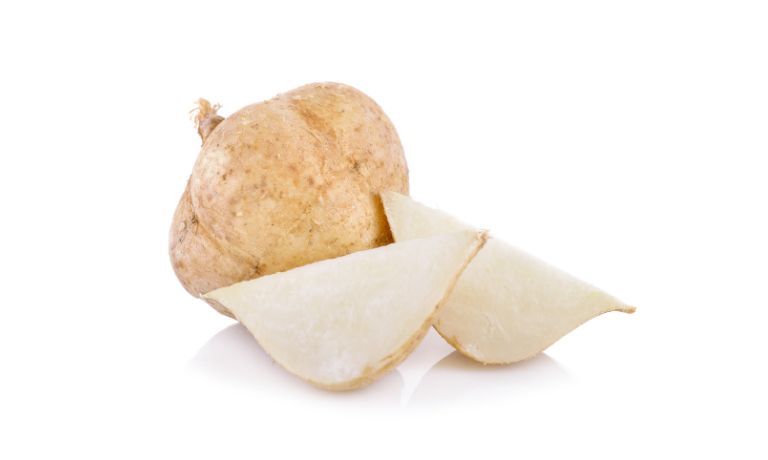
Substitutes For Jicama
Jicama, a root vegetable native to Mexico, is known for its crunchy texture and sweet flavor.
While it’s difficult to find an exact substitute for jicama that tastes or feels the same, several alternatives can be used.
Celery Root
Celery root, also known as celeriac, is a root vegetable that belongs to the same family as celery and parsley.
It has a mild flavor and crunchy texture that can be used in savory and sweet dishes.
[display-posts id=”2112″ image_size=”thumbnail” posts_per_page=”1″]
Celery root can be roasted, mashed, grated into soups or salads, or diced and sautéed.
It is often used as a substitute for jicama, which has a similar crunchy texture, but with a lighter flavor.
Celery root has higher levels of vitamins and minerals such as calcium, vitamin C, potassium, folate, and iron than jicama.
This makes it an excellent choice for adding more nutrition to your dishes.
Celery root can also be a great addition to many vegan and vegetarian recipes due its dense texture and flavor.

Cassava
Cassava is a plant native to South America that belongs to the Euphorbiaceae family and has become one of the world’s most important food crops.
It is a major source of carbohydrates for many parts of the world and provides an essential dietary staple for people in tropical and subtropical areas.
Cassava is also known as yuca, manioc, Brazilian arrowroot, mandioca, and tapioca.
Cassava can be used as a substitute for jicama in various recipes due to its similarly crunchy texture when raw and similar starchy flavor when cooked.
It can be boiled, roasted, fried or mashed like jicama and is often used in soups, salads or as a side dish.
In the Caribbean, cassava makes sweet bread and cakes, usually served with cheese, butter, and honey.
Additionally, cassava can be dried and ground into flour for baking or fried into chips.
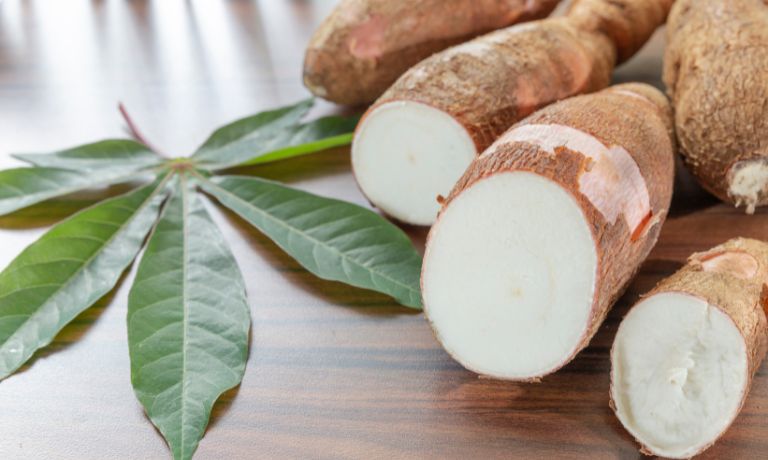
Water Chestnuts
Water chestnuts are a type of vegetable that is commonly used in Asian cooking.
They have a light, crunchy texture and nutty flavor, making them perfect for adding to stir-fries or salads.
[display-posts id=”2996″ image_size=”thumbnail” posts_per_page=”1″]
They are also great substitutes for jicama when unavailable due to their similar texture and subtle sweetness.
Water chestnuts are high in fiber and low in calories, making them a healthy alternative to jicama.
They contain important vitamins and minerals like vitamin B6, magnesium, potassium, and calcium.
Additionally, water chestnuts have antioxidant properties that support heart health and reduce inflammation.
When substituting water chestnuts for jicama, it’s important to cook them first as they can be difficult to digest when raw.
To prepare them, simply boil or steam the chestnuts until tender.
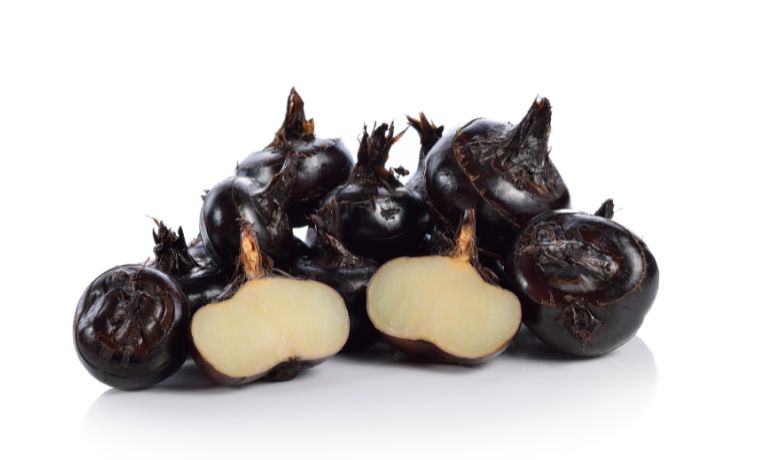
Turnips
Turnips are a vegetable that has been enjoyed around the world for centuries.
They have a mild, slightly sweet flavor and can be eaten raw or cooked in many different dishes.
Turnips are packed with essential vitamins and minerals, making them an excellent source of nutrition.
Additionally, they contain high amounts of fiber, which helps to support healthy digestion and can help lower cholesterol levels.
Turnips can make an excellent substitute for jicama, as they are both crunchy and juicy vegetables that offer a range of health benefits.
They contain fewer calories than jicama but are still rich in essential vitamins and minerals.
Additionally, turnips have a slightly sweet flavor similar to jicama.
Turnips are also easier to find than jicama in most grocery stores, making them a convenient option for those who don’t have access to specialty markets.
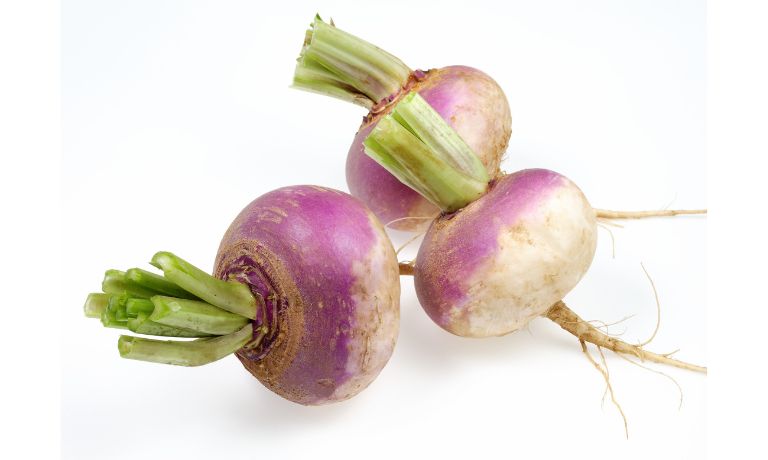
Sweet Potatoes
Sweet potatoes (Ipomoea batatas) are root vegetables from the morning glory family.
They have orange flesh and come in many varieties, including white, purple, and yellow.
They are incredibly nutrient-dense, containing high amounts of vitamins A and C and dietary fiber.
[display-posts id=”2979″ image_size=”thumbnail” posts_per_page=”1″]
Sweet potatoes are rich in essential minerals like potassium and magnesium that help promote healthy bones.
They also provide a good source of complex carbohydrates, important for maintaining energy levels throughout the day.
Additionally, sweet potatoes are high in dietary fiber, which is beneficial for digestive health and aids in absorbing other nutrients.

Jerusalem Artichoke
Jerusalem artichokes, also known as sunchokes, are a type of root vegetable from the sunflower family.
They look like knobby potatoes and have a sweet, nutty flavor.
Jerusalem artichokes can be eaten raw or cooked, just like jicama.
They contain high levels of inulin, a dietary fiber that helps regulate blood sugar levels.
They’re also a good source of iron, magnesium, potassium, phosphorus, and thiamine.
They can be used in salads, stir-fries, roasted, boiled, mashed, or added to soups.
Jerusalem artichokes are an easy way to incorporate more vegetables into your diet and add variety to your meals!

Daikon Radish
Daikon Radish is a type of large, white radish that originates from Southeast Asia.
It has an elongated shape, and its skin can range from white to light green.
[display-posts id=”2952″ image_size=”thumbnail” posts_per_page=”1″]
Daikon Radish has a mild flavor that is slightly spicy and sweet, making it a versatile ingredient for many dishes.
Daikon Radish can be a great substitute for Jicama because it has a similar crunchy texture and sweet-spicy flavor.
It is also a good source of dietary fiber, vitamins, minerals, and other beneficial compounds.
In addition, Daikon Radish can be eaten raw or cooked in soups, salads, stir-fries, and other dishes.
It also has a low glycemic index that can help regulate blood sugar levels.
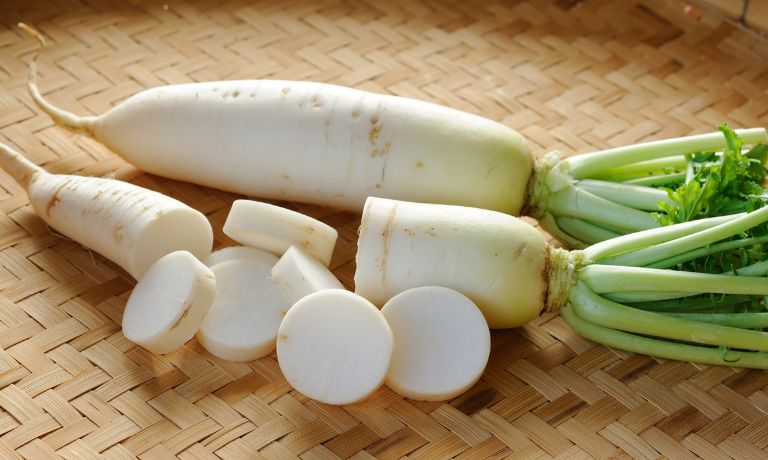
FAQs
Can You Use Apple Instead Of Jicama?
No, you cannot use apples instead of jicama.
Apples and jicama are two different fruits with different flavors and textures, so you will need more than one for the other to give you the same results.
Is Jicama The Same As A Turnip?
No, jicama is not the same as a turnip. While both are root vegetables, they have different flavors and textures.
Jicama has a sweet flavor and crunchy texture; while turnips are usually more savory with a firm texture.
Additionally, jicama is much larger than turnips.
Can You Use Daikon Instead Of Jicama?
Yes, you can use daikon instead of jicama in many recipes.
Daikon has a slightly milder flavor and softer texture than jicama, but it can be used interchangeably in salads, slaws, stir-fries, and other dishes.
Conclusion
Jicama is a nutritious root vegetable that can be used in many recipes.
Unfortunately, it can sometimes be difficult to find or too expensive for some people.
Fortunately, several options to substitute for jicama can provide similar flavor and texture such as potatoes, cassava, Jerusalem artichoke, daikon radish, and celery root.
These substitutes are often more accessible and provide additional nutritional benefits.
So, if you’re looking to add more variety or nutrition to your meals, consider giving one of these jicama substitutes a try!

